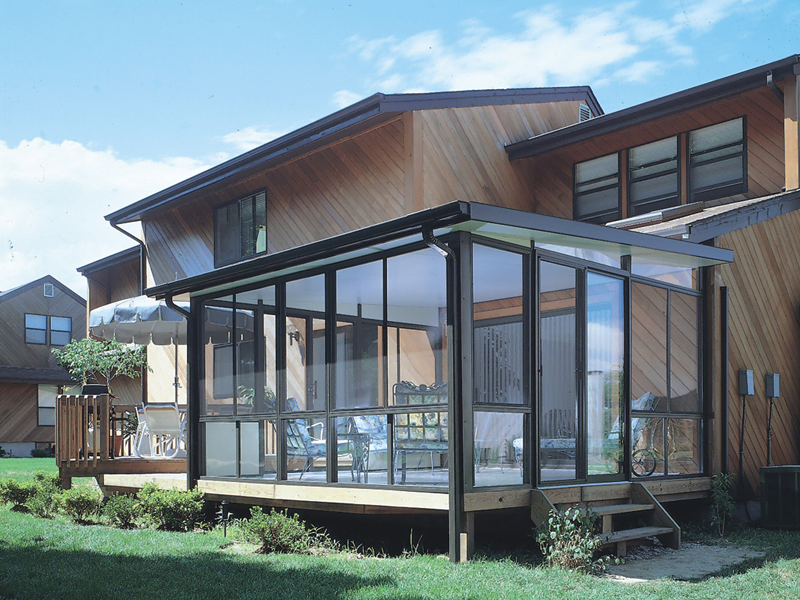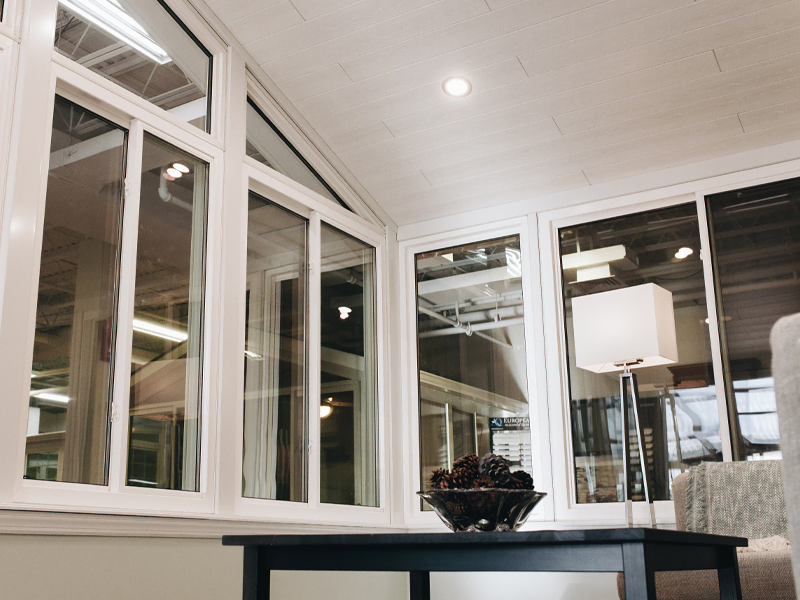
All You Need To Know About Our Sunroom Additions For Your Home In Ridge, NY
Provider of Premium Sunrooms, Addition Solutions, Pergolas, LifeRoom, LifeRoom Louvered Systems, and more for all residents in Nassau County!
Get a free estimate
Awards
With our many years of experience we have earned many home remodeling awards we take pride in.




Client Testimonials
striving for great experiences

Read More
I had an exceptional experience with Four Seasons Sunrooms. They were customer satisfaction oriented and their prices were by far the most reasonable. They came out to assess my needs right away, and I had received great design advice and prompt appointments.

Read More
They are professional and friendly people who took the time to explain how the steps leading up to the completion of the sunroom and kept up with communication along the way. I would highly recommend them to any of my friends and family!

Read More
We love our new sunroom! Four Seasons worked with us to get all the necessary permits and town hearings to move forward. The workers were hard working and courteous, in very cold weather! We are enjoying our new beautiful living space.

Read More
Their products are beautiful, plus there's so many sunroom styles to choose from. I'm really impressed by the impeccable work they've done. In addition, their staff members are super friendly!
Previous
Next
Our Sunroom Contractors Will add an elegant touch to your home.
Sometimes you want to expand your home’s footprint, and the most common approach is to hire a contractor from Four Seasons Sunroom to construct full-size addition solutions or room addition that adds a bump-out or becomes an extension to the primary footprint of your home.
As a result, stick-built homes may easily scare budget-conscious homeowners when general contractors present their estimates for the project. At the very least, a custom-built addition from other contractors will cost more than $100,000, with extras costing even more.
One of the perks of adding a sunroom to your home is that you can enjoy both inside and outside living spaces at the same time. Adding a solarium is a great choice in Suffolk County, since it costs just as much as a typical stick-built addition.
Factors To Look Into If You Are Considering Sunroom Addition To Your Home
1) Heating & Cooling
Placing a sunroom or lief room in your home often leads to heating and cooling issues. Sunrooms don’t need central heating and cooling, and HVAC systems are standard with custom-built sunrooms. Regarding room extensions, they must be connected to the HVAC system of the house in which they are being built.
2) Electrification Services
While it’s uncommon for sunrooms and liferooms to be wired for electricity, this is increasingly becoming the case. It mainly comes about when they are custom-built. Instructions for a pre-built sunroom enclosure will come with the kit.
Sunrooms in VarCounty County can provide a stunning new living space. However, they are not as sturdy or as steady. They must adhere to the same building code standards that other rooms in the home must, given that they’re not built from bricks, cement and mortar.
3) The cost of building a house is a significant barrier to home ownership. It’s also different depending on where you live.
For most rooms, including sunrooms and porch additions, the average cost of construction is less than a standard room extension.
Although you may not need a sunroom to maximize your home’s square footage, there’s a significant upfront investment with the cost of site-built complete sunrooms. However, the long-term resale value will be worth it.
4) Term For Additional Space
Adding the space is treated differently from adding an actual room. A natural extension or room addition, on the other hand, increases the value of your property significantly with different styles. In addition to providing additional living space, a sunroom installation may serve as a place to cultivate plants, keep pets, or even set up a spa.
Why Consider Our Sunroom Addition?
A sun room is an area where you can stay cool and comfortable throughout a majority of the year. You can escape from harsh weather, such as heat, cold, rain, wind, snow and pests.
At varcompanyname.com, we always seek to enhance your home’s use and value with our collection of sunrooms and life rooms. Our offering includes four-season models for any purpose you may have in mind, including:
- To be protected from the sun or rain as you enjoy the scenery
- Taking a break in a tranquil environment
- A view from your home office
- Additional use-cases such as a place to meet with family and friends
- Activities, games, and crafts take place here
- To work out and exercise without the oppressive heat
- Room with plants and more!


Call Us Today For Beautiful Sunroom Additions!
If you’re considering a sunroom expansion for your home, contact Four Seasons Sunroom. This company has been in the home improvement business for more than 40 years, so they’ll have expertise in different styles and offer service at affordable prices.
A total transformation of your space can be achieved with Four Seasons Sunroom’s sunroom additions from Ridge, which are available in NY. Contact our specialists if you’re anywhere in Suffolk County, and contact the company on the phone number listed on their website.
Call Us Today!!
In 1693, William “Tangier” Smith, who owned a homestead in Setauket, was allowed to purchase a large tract of land on the South Shore of Long Island in recognition of his being mayor of Tangier in Africa. The land, called Manor St. George, stretched from the Carmans River (then called the Connecticut River) in the west to the edge of the town of Southampton in the east, with a northern border around present-day New York State Route 25, as much as 81,000 acres (330 km2) of land. He made his manor seat on the South Shore in present-day Mastic, and the northern part, now the south side of Ridge, was called “The Swamp” or “Longswamp”. A house wasn’t built at Longswamp until after the American Revolution. In 1817, William Sydney Smith inhabited the house and changed the name to Longwood.
In 1955, what then remained of William Smith’s original manor was primarily located in Ridge and was surrounded by the world growing up around it, in the form of the Brookhaven National Laboratory and the surrounding areas becoming increasingly populated. Longwood’s 750 acres (300 ha) fell into the hands of Elbert Clayton Smith, who immediately moved his family from California to live there. He seems to have been very generous to his new community; his donations included 51 acres (21 ha) to the school board for the construction of Longwood High School and 6 acres (2.4 ha) to Middle Island Presbyterian Church. In 1967, Elbert Smith died, and the Longwood Estate was carved into housing developments and nearly destroyed until enough noise was made about preservation to have the house and 35 acres (14 ha) of land given to the Town of Brookhaven in 1974. The Smith Estate was added to the National Register of Historic Places in 1981.
In 1738, northern Ridge was settled by widower Samuel Randall of North Stonington, Connecticut; his only son Stephen Randall and his descendants farmed a 4,000-acre (1,600 ha) plot of ground that Samuel had always referred to as “the Ridge” based on the geographical terrain. First called “Randallville”, Ridge was the name selected by its residents for postal delivery. The Randall burial plot near the William Floyd Parkway includes the grave of Lt. Stephen Randall (1736-1818), patriot of the American Revolution and a Suffolk County Militia veteran of the Battle of Long Island. Graves of Randall’s wife Elizabeth Swezey (1747-1834) and several descendants are also within the plot.
Learn more about Ridge.Additional Links
Here are some general contractor-related links:
Albertson
Atlantic Beach
Baldwin
Baldwin Harbor
Barnum Island
Baxter Estates
Bay Park
Bayville
Bellerose
Bellerose Terrace
Bellmore
Bethpage
Brookville
Carle Place
Cedarhurst
Centre Island
Cove Neck
East Atlantic Beach
East Garden City
East Hills
East Massapequa
East Meadow
East Norwich
East Rockaway
East Williston
Elmont
Farmingdale
Floral Park
Flower Hill
Franklin Square
Freeport
Garden City
Garden City Park
Garden City South
Glen Cove
Glen Head
Glenwood Landing
Great Neck
Great Neck Estates
Great Neck Gardens
Great Neck Plaza
Greenvale
Harbor Hills
Harbor Isle
Hempstead
Herricks
Hewlett
Hewlett Bay Park
Hewlett Harbor
Hewlett Neck
Hicksville
Inwood
Island Park
Jericho
Kensington
Kings Point
Lake Success
Lakeview
Lattingtown
Laurel Hollow
Lawrence
Levittown
Lido Beach
Locust Valley
Long Beach
Lynbrook
Malverne
Malverne Park Oaks
Manhasset
Manhasset Hills
Manorhaven
Massapequa
Massapequa Park
Matinecock
Merrick
Mill Neck
Mineola
Munsey Park
Muttontown
New Cassel
New Hyde Park
North Bellmore
North Hempstead
North Hills
North Lynbrook
North Massapequa
North Merrick
North New Hyde Park
North Valley Stream
North Wantagh
Oceanside
Old Bethpage
Old Brookville
Old Westbury
Oyster Bay
Oyster Bay Cove
Plainedge
Plainview
Plandome
Plandome Heights
Plandome Manor
Point Lookout
Port Washington
Port Washington North
Rockville Centre
Roosevelt
Roslyn
Roslyn Estates
Roslyn Harbor
Roslyn Heights
Russell Gardens
Saddle Rock
Saddle Rock Estates
Salisbury
Sands Point
Sea Cliff
Seaford
Searingtown
South Farmingdale
South Floral Park
South Hempstead
South Valley Stream
Stewart Manor
Syosset
Thomaston
Uniondale
University Gardens
Upper Brookville
Valley Stream
Wantagh
West Hempstead
Westbury
Williston Park
Woodbury
Woodmere
Woodsburgh
Amagansett
Amityville
Aquebogue
Asharoken
Babylon
Baiting Hollow
Bay Shore
Bay Wood
Bayport
Belle Terre
Bellport
Blue Point
Bohemia
Brentwood
Bridgehampton
Brightwaters
Brookhaven
Calverton
Center Moriches
Centereach
Centerport
Central Islip
Cold Spring Harbor
Commack
Copiague
Coram
Cutchogue
Deer Park
Dix Hills
East Farmingdale
East Hampton
East Hampton North
East Islip
East Marion
East Moriches
East Northport
East Patchogue
East Quogue
East Setauket
East Shoreham
Eastport
Eatons Neck
Elwood
Farmingville
Fire Island
Flanders
Fort Salonga
Gilgo
Gordon Heights
Great River
Greenlawn
Greenport
Halesite
Hampton Bays
Hauppauge
Head of the Harbor
Holbrook
Holtsville
Huntington
Huntington Bay
Huntington Station
Islandia
Islip
Islip Terrace
Jamesport
Kings Park
Lake Grove
Lake Ronkonkoma
Laurel
Lindenhurst
Lloyd Harbor
Manorville
Mastic
Mastic Beach
Mattituck
Medford
Melville
Middle Island
Miller Place
Montauk
Moriches
Mount Sinai
Napeague
Nesconset
New Suffolk
Nissequogue
North Amityville
North Babylon
North Bay Shore
North Bellport
North Great River
North Haven
North Lindenhurst
North Patchogue
North Sea
Northampton
Northport
Northville
Northwest Harbor
Noyack
Oak Beach
Oakdale
Ocean Beach
Old Field
Orient
Patchogue
Peconic
Poquott
Port Jefferson
Port Jefferson Station
Quiogue
Quogue
Remsenburg
Ridge
Riverhead
Riverside
Rocky Point
Ronkonkoma
Sag Harbor
Sagaponack
Sayville
Selden
Setauket
Shelter Island
Shirley
Shoreham
Smithtown
Sound Beach
South Huntington
Southampton
Southold
Speonk
Springs
St. James
Stony Brook
Stony Brook University
Terryville
Tuckahoe
Village of the Branch
Wading River
Wainscott
Water Mill
West Babylon
West Bay Shore
West Hills
West Islip
West Sayville
Westhampton
Westhampton Beach
Wheatley Heights
Wyandanch
Yaphank
Albertson
Atlantic Beach
Baldwin
Baldwin Harbor
Barnum Island
Baxter Estates
Bay Park
Bayville
Bellerose
Bellerose Terrace
Bellmore
Bethpage
Brookville
Carle Place
Cedarhurst
Centre Island
Cove Neck
East Atlantic Beach
East Garden City
East Hills
East Massapequa
East Meadow
East Norwich
East Rockaway
East Williston
Elmont
Farmingdale
Floral Park
Flower Hill
Franklin Square
Freeport
Garden City
Garden City Park
Garden City South
Glen Cove
Glen Head
Glenwood Landing
Great Neck
Great Neck Estates
Great Neck Gardens
Great Neck Plaza
Greenvale
Harbor Hills
Harbor Isle
Hempstead
Herricks
Hewlett
Hewlett Bay Park
Hewlett Harbor
Hewlett Neck
Hicksville
Inwood
Island Park
Jericho
Kensington
Kings Point
Lake Success
Lakeview
Lattingtown
Laurel Hollow
Lawrence
Levittown
Lido Beach
Locust Valley
Long Beach
Lynbrook
Malverne
Malverne Park Oaks
Manhasset
Manhasset Hills
Manorhaven
Massapequa
Massapequa Park
Matinecock
Merrick
Mill Neck
Mineola
Munsey Park
Muttontown
New Cassel
New Hyde Park
North Bellmore
North Hempstead
North Hills
North Lynbrook
North Massapequa
North Merrick
North New Hyde Park
North Valley Stream
North Wantagh
Oceanside
Old Bethpage
Old Brookville
Old Westbury
Oyster Bay
Oyster Bay Cove
Plainedge
Plainview
Plandome
Plandome Heights
Plandome Manor
Point Lookout
Port Washington
Port Washington North
Rockville Centre
Roosevelt
Roslyn
Roslyn Estates
Roslyn Harbor
Roslyn Heights
Russell Gardens
Saddle Rock
Saddle Rock Estates
Salisbury
Sands Point
Sea Cliff
Seaford
Searingtown
South Farmingdale
South Floral Park
South Hempstead
South Valley Stream
Stewart Manor
Syosset
Thomaston
Uniondale
University Gardens
Upper Brookville
Valley Stream
Wantagh
West Hempstead
Westbury
Williston Park
Woodbury
Woodmere
Woodsburgh
Amagansett
Amityville
Aquebogue
Asharoken
Babylon
Baiting Hollow
Bay Shore
Bay Wood
Bayport
Belle Terre
Bellport
Blue Point
Bohemia
Brentwood
Bridgehampton
Brightwaters
Brookhaven
Calverton
Center Moriches
Centereach
Centerport
Central Islip
Cold Spring Harbor
Commack
Copiague
Coram
Cutchogue
Deer Park
Dix Hills
East Farmingdale
East Hampton
East Hampton North
East Islip
East Marion
East Moriches
East Northport
East Patchogue
East Quogue
East Setauket
East Shoreham
Eastport
Eatons Neck
Elwood
Farmingville
Fire Island
Flanders
Fort Salonga
Gilgo
Gordon Heights
Great River
Greenlawn
Greenport
Halesite
Hampton Bays
Hauppauge
Head of the Harbor
Holbrook
Holtsville
Huntington
Huntington Bay
Huntington Station
Islandia
Islip
Islip Terrace
Jamesport
Kings Park
Lake Grove
Lake Ronkonkoma
Laurel
Lindenhurst
Lloyd Harbor
Manorville
Mastic
Mastic Beach
Mattituck
Medford
Melville
Middle Island
Miller Place
Montauk
Moriches
Mount Sinai
Napeague
Nesconset
New Suffolk
Nissequogue
North Amityville
North Babylon
North Bay Shore
North Bellport
North Great River
North Haven
North Lindenhurst
North Patchogue
North Sea
Northampton
Northport
Northville
Northwest Harbor
Noyack
Oak Beach
Oakdale
Ocean Beach
Old Field
Orient
Patchogue
Peconic
Poquott
Port Jefferson
Port Jefferson Station
Quiogue
Quogue
Remsenburg
Ridge
Riverhead
Riverside
Rocky Point
Ronkonkoma
Sag Harbor
Sagaponack
Sayville
Selden
Setauket
Shelter Island
Shirley
Shoreham
Smithtown
Sound Beach
South Huntington
Southampton
Southold
Speonk
Springs
St. James
Stony Brook
Stony Brook University
Terryville
Tuckahoe
Village of the Branch
Wading River
Wainscott
Water Mill
West Babylon
West Bay Shore
West Hills
West Islip
West Sayville
Westhampton
Westhampton Beach
Wheatley Heights
Wyandanch
Yaphank
Albertson
Atlantic Beach
Baldwin
Baldwin Harbor
Barnum Island
Baxter Estates
Bay Park
Bayville
Bellerose
Bellerose Terrace
Bellmore
Bethpage
Brookville
Carle Place
Cedarhurst
Centre Island
Cove Neck
East Atlantic Beach
East Garden City
East Hills
East Massapequa
East Meadow
East Norwich
East Rockaway
East Williston
Elmont
Farmingdale
Floral Park
Flower Hill
Franklin Square
Freeport
Garden City
Garden City Park
Garden City South
Glen Cove
Glen Head
Glenwood Landing
Great Neck
Great Neck Estates
Great Neck Gardens
Great Neck Plaza
Greenvale
Harbor Hills
Harbor Isle
Hempstead
Herricks
Hewlett
Hewlett Bay Park
Hewlett Harbor
Hewlett Neck
Hicksville
Inwood
Island Park
Jericho
Kensington
Kings Point
Lake Success
Lakeview
Lattingtown
Laurel Hollow
Lawrence
Levittown
Lido Beach
Locust Valley
Long Beach
Lynbrook
Malverne
Malverne Park Oaks
Manhasset
Manhasset Hills
Manorhaven
Massapequa
Massapequa Park
Matinecock
Merrick
Mill Neck
Mineola
Munsey Park
Muttontown
New Cassel
New Hyde Park
North Bellmore
North Hempstead
North Hills
North Lynbrook
North Massapequa
North Merrick
North New Hyde Park
North Valley Stream
North Wantagh
Oceanside
Old Bethpage
Old Brookville
Old Westbury
Oyster Bay
Oyster Bay Cove
Plainedge
Plainview
Plandome
Plandome Heights
Plandome Manor
Point Lookout
Port Washington
Port Washington North
Rockville Centre
Roosevelt
Roslyn
Roslyn Estates
Roslyn Harbor
Roslyn Heights
Russell Gardens
Saddle Rock
Saddle Rock Estates
Salisbury
Sands Point
Sea Cliff
Seaford
Searingtown
South Farmingdale
South Floral Park
South Hempstead
South Valley Stream
Stewart Manor
Syosset
Thomaston
Uniondale
University Gardens
Upper Brookville
Valley Stream
Wantagh
West Hempstead
Westbury
Williston Park
Woodbury
Woodmere
Woodsburgh
Amagansett
Amityville
Aquebogue
Asharoken
Babylon
Baiting Hollow
Bay Shore
Bay Wood
Bayport
Belle Terre
Bellport
Blue Point
Bohemia
Brentwood
Bridgehampton
Brightwaters
Brookhaven
Calverton
Center Moriches
Centereach
Centerport
Central Islip
Cold Spring Harbor
Commack
Copiague
Coram
Cutchogue
Deer Park
Dix Hills
East Farmingdale
East Hampton
East Hampton North
East Islip
East Marion
East Moriches
East Northport
East Patchogue
East Quogue
East Setauket
East Shoreham
Eastport
Eatons Neck
Elwood
Farmingville
Fire Island
Flanders
Fort Salonga
Gilgo
Gordon Heights
Great River
Greenlawn
Greenport
Halesite
Hampton Bays
Hauppauge
Head of the Harbor
Holbrook
Holtsville
Huntington
Huntington Bay
Huntington Station
Islandia
Islip
Islip Terrace
Jamesport
Kings Park
Lake Grove
Lake Ronkonkoma
Laurel
Lindenhurst
Lloyd Harbor
Manorville
Mastic
Mastic Beach
Mattituck
Medford
Melville
Middle Island
Miller Place
Montauk
Moriches
Mount Sinai
Napeague
Nesconset
New Suffolk
Nissequogue
North Amityville
North Babylon
North Bay Shore
North Bellport
North Great River
North Haven
North Lindenhurst
North Patchogue
North Sea
Northampton
Northport
Northville
Northwest Harbor
Noyack
Oak Beach
Oakdale
Ocean Beach
Old Field
Orient
Patchogue
Peconic
Poquott
Port Jefferson
Port Jefferson Station
Quiogue
Quogue
Remsenburg
Ridge
Riverhead
Riverside
Rocky Point
Ronkonkoma
Sag Harbor
Sagaponack
Sayville
Selden
Setauket
Shelter Island
Shirley
Shoreham
Smithtown
Sound Beach
South Huntington
Southampton
Southold
Speonk
Springs
St. James
Stony Brook
Stony Brook University
Terryville
Tuckahoe
Village of the Branch
Wading River
Wainscott
Water Mill
West Babylon
West Bay Shore
West Hills
West Islip
West Sayville
Westhampton
Westhampton Beach
Wheatley Heights
Wyandanch
Yaphank
Albertson
Atlantic Beach
Baldwin
Baldwin Harbor
Barnum Island
Baxter Estates
Bay Park
Bayville
Bellerose
Bellerose Terrace
Bellmore
Bethpage
Brookville
Carle Place
Cedarhurst
Centre Island
Cove Neck
East Atlantic Beach
East Garden City
East Hills
East Massapequa
East Meadow
East Norwich
East Rockaway
East Williston
Elmont
Farmingdale
Floral Park
Flower Hill
Franklin Square
Freeport
Garden City
Garden City Park
Garden City South
Glen Cove
Glen Head
Glenwood Landing
Great Neck
Great Neck Estates
Great Neck Gardens
Great Neck Plaza
Greenvale
Harbor Hills
Harbor Isle
Hempstead
Herricks
Hewlett
Hewlett Bay Park
Hewlett Harbor
Hewlett Neck
Hicksville
Inwood
Island Park
Jericho
Kensington
Kings Point
Lake Success
Lakeview
Lattingtown
Laurel Hollow
Lawrence
Levittown
Lido Beach
Locust Valley
Long Beach
Lynbrook
Malverne
Malverne Park Oaks
Manhasset
Manhasset Hills
Manorhaven
Massapequa
Massapequa Park
Matinecock
Merrick
Mill Neck
Mineola
Munsey Park
Muttontown
New Cassel
New Hyde Park
North Bellmore
North Hempstead
North Hills
North Lynbrook
North Massapequa
North Merrick
North New Hyde Park
North Valley Stream
North Wantagh
Oceanside
Old Bethpage
Old Brookville
Old Westbury
Oyster Bay
Oyster Bay Cove
Plainedge
Plainview
Plandome
Plandome Heights
Plandome Manor
Point Lookout
Port Washington
Port Washington North
Rockville Centre
Roosevelt
Roslyn
Roslyn Estates
Roslyn Harbor
Roslyn Heights
Russell Gardens
Saddle Rock
Saddle Rock Estates
Salisbury
Sands Point
Sea Cliff
Seaford
Searingtown
South Farmingdale
South Floral Park
South Hempstead
South Valley Stream
Stewart Manor
Syosset
Thomaston
Uniondale
University Gardens
Upper Brookville
Valley Stream
Wantagh
West Hempstead
Westbury
Williston Park
Woodbury
Woodmere
Woodsburgh
Amagansett
Amityville
Aquebogue
Asharoken
Babylon
Baiting Hollow
Bay Shore
Bay Wood
Bayport
Belle Terre
Bellport
Blue Point
Bohemia
Brentwood
Bridgehampton
Brightwaters
Brookhaven
Calverton
Center Moriches
Centereach
Centerport
Central Islip
Cold Spring Harbor
Commack
Copiague
Coram
Cutchogue
Deer Park
Dix Hills
East Farmingdale
East Hampton
East Hampton North
East Islip
East Marion
East Moriches
East Northport
East Patchogue
East Quogue
East Setauket
East Shoreham
Eastport
Eatons Neck
Elwood
Farmingville
Fire Island
Flanders
Fort Salonga
Gilgo
Gordon Heights
Great River
Greenlawn
Greenport
Halesite
Hampton Bays
Hauppauge
Head of the Harbor
Holbrook
Holtsville
Huntington
Huntington Bay
Huntington Station
Islandia
Islip
Islip Terrace
Jamesport
Kings Park
Lake Grove
Lake Ronkonkoma
Laurel
Lindenhurst
Lloyd Harbor
Manorville
Mastic
Mastic Beach
Mattituck
Medford
Melville
Middle Island
Miller Place
Montauk
Moriches
Mount Sinai
Napeague
Nesconset
New Suffolk
Nissequogue
North Amityville
North Babylon
North Bay Shore
North Bellport
North Great River
North Haven
North Lindenhurst
North Patchogue
North Sea
Northampton
Northport
Northville
Northwest Harbor
Noyack
Oak Beach
Oakdale
Ocean Beach
Old Field
Orient
Patchogue
Peconic
Poquott
Port Jefferson
Port Jefferson Station
Quiogue
Quogue
Remsenburg
Ridge
Riverhead
Riverside
Rocky Point
Ronkonkoma
Sag Harbor
Sagaponack
Sayville
Selden
Setauket
Shelter Island
Shirley
Shoreham
Smithtown
Sound Beach
South Huntington
Southampton
Southold
Speonk
Springs
St. James
Stony Brook
Stony Brook University
Terryville
Tuckahoe
Village of the Branch
Wading River
Wainscott
Water Mill
West Babylon
West Bay Shore
West Hills
West Islip
West Sayville
Westhampton
Westhampton Beach
Wheatley Heights
Wyandanch
Yaphank
